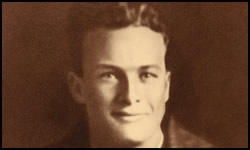Priv. Hiram O. Taylor, a member of E Co., 23d infantry, Second American Division in France, aged 27 years, was killed in action in France, Sept. 13, according to official information received in Sterling by his mother, Mrs. George A. Elliott. He had previously been wounded by a shell splinter in his arm, recovered and returned to duty. was killed in action in France, Sept. 13, according to official information received in Sterling by his mother, Mrs. George A. Elliott. He had previously been wounded by a shell splinter in his arm, recovered and returned to duty.
He enlisted in Lowell in June, 1917 and was sent to a camp at Syracuse. After several weeks of intensive training he left with his regiment for France and has been at the front in all the recent drives. A short time before the news of his death came his mother received a letter from him enclosing flowers he had picked in "No man's land".
Besides his mother, he leaves one brother, Wilfred, residing in Sterling.
His mother is anxious to have his body brought home when the war ends and will make such request.
from: The Clinton Courant, Friday, October 18, 1918 |
Hiram O. Taylor American Legion Post 189

Born 17 Oct. 1891, son of Mrs. George Elliott, Sterling, MA. Hiram O. Taylor enlisted June 1917 in Lowell, Ma. Two months later he went to Camp Syracuse for 2 weeks training. He was assigned to E Co, 23rd Infantry Regiment, originally formed in 1812. Sent overseas, the regiment arrived at St. Nazaire in September 1917 and received more intense training with French army veterans. His regiment was assigned on 21st of that month to the newly forming 2nd Infantry Division, consisting of 1 brigade of Army infantry, 1 brigade of Marines, an artillery brigade, and various support units. The 2nd division was officially born on 26 October 1917 in Bourmont, France. It was the first American Army Division to be formed overseas and to be under command by both the British and French. In addition, Marine Generals BG. C.A. Doyen and MG. John A. Lejeune also commanded the division. The Army's 2nd Infantry Division (Indian Head Division) included the Army's 9th Infantry Regiment and the Marine Corps's 4th and 5th Regiments as well as a machine gun battalion. The 2nd Division drew first blood in Belleau Wood, followed by actions in; Chateau-Thierry, Soissons and Mont Blanc and participated in the Meuse-Argonne offensive. The regiment also has Campaign ribbons for battle actions in: The AISNE, ST. MIHIEL, MEUSE-ARGONNE. For its service in the Soisson and Mont Blanc campaign, the regiment was awarded the French Fourragere. As an infantry man of the 23rd Infantry Regiment, Hiram O. Taylor would have participated in many bloody battles, from the 2nd Division's inception, until his death. Hiram had previously received shrapnel wounds but was sent back into action. Two months before the armistice, on 13 Sept. 1918, during the battle in the St. Mihiel salient, where the 2nd division was used as shock troops and the 23rd Infantry as the lead regiment, Hiram O. Taylor gave his life. He was the first and only son of Sterling to be killed in action, during the "war to end all wars". His mother requested his body be sent home, and on Oct 18th, he was brought back to Sterling for burial, where a horse drawn hearse carried him to his final rest in Oak Hill Cemetery. For his sacrifice, American Legion post 189 is named in his honor.
In a letter dated 22 December 1918 from J. F. Groshane, 1st Lieutenant Company “E” 23rd Infantry to the Mother of Hiram Taylor regarding the death of her son, he writes: “On September 12, 1918, at 5:30 A.M. this Company took part in the reduction of the St. Mihiel salient, our sector being what was considered the hard part of the line, it was on the second day of the engagement that an artillery shell struck so near your son that he was instantly killed. Captain N. A. Miller was then in command of the Company. He is now a major in the same Regiment. This Company is part of the 23rd Infantry, who with the Ninth Infantry, form a Brigade, and the Marines form the other Brigade which forms the Second Division, all are regular Army troops, and have ever been considered one of the best divisions over here, and were made Shock troops after stopping the enemy at Chateau Thierry last June. And any man who went through the engagement on July 18 knew what war was and your son was among those who went thru all that and knew the dangers and still never hesitated one moment, and it is the conduct of such men that made possible our ultimate victory over the enemy.” |

